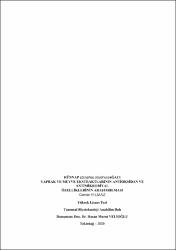| dc.contributor.author | Yılmaz, Gamze | |
| dc.date.accessioned | 2020-02-05T07:23:22Z | |
| dc.date.available | 2020-02-05T07:23:22Z | |
| dc.date.issued | 2019 | |
| dc.identifier.uri | https://hdl.handle.net/20.500.11776/3568 | |
| dc.description.abstract | Bu tez çalışmasında Hayrabolu İlçesi Karabürçek Mahallesi’nde doğal olarak yetişen hünnap (Zizyphus zizyphus) ağacı yaprak ve meyve ekstraktlarının antioksidan ve antimikrobiyal özellikleri incelenmiştir. Yaprak ve meyvelerden su – metanol ekstraksiyonu yöntemi kullanılarak ekstraktlar elde edilmiştir. Ekstraktların antioksidan özelliklerini belirlemek amacıyla toplam flavonoid miktarı, toplam fenolik madde, toplam antioksidan yakalama kapasitesi tayini ve fenolik madde kompozisyonu tayini yapılmıştır. Ayrıca meyvelerden elde edilen ekstraktlarda şeker analizi yapılmıştır. Elde edilen ekstraktların antimikrobiyal etkileri Aspergillus parasiticus (DMS 5771), Zygosaccharomyces rouxii ATCC 28253 ve Escherichia coli ATCC 25922 üzerinde in vitro olarak araştırılmıştır. Araştırma bulguları hünnap ağacı yaprak ve meyve ekstraktlarının değişen oranlarda antioksidan ve antimikrobiyal özellikte olduğunu göstermektedir. Yaprak ve meyve numuneleri farklı yaş aralığına sahip ağaçlardan toplandığından dolayı antioksidan ve antimikrobiyal özellikleri arasında farklar olduğu belirlenmiştir. En yüksek toplam flavonoid miktarı ve toplam fenolik madde içeriği yaprak ekstraktından sırasıyla 1047,00 mg CE/L ve 8292,00 mg GAE/L olarak tespit edilmiştir. DPPH metodu ile tespit edilen antioksidan kapasite değeri yaprak su ekstraksiyonu yöntemi ile elde edilen ekstraktında4,89 ?l/L bulunmuştur. Hünnap ağacı yaprak ve meyve ekstraktlarının fenolik madde kompozisyonu da incelenmiştir. Gallik asit, 3-4 hidroksi benzoik asit, kateşin, vanilik asit, syringic asit, epikateşin, kaftarik asit, klorojenik asit, kafeik asit, kumarik asit, ferulik asit, rutin trihidrat, kamperol 3-glukozid ve kuarsetin olmak üzere 14 adet fenolik bileşen tespit edilmiştir. Antimikrobiyal etkileri değerlendirildiğinde en yüksek etkiyi olgunlaşmamış meyvenin metanol ekstraksiyonu sonucu elde edilen ekstrakt göstermiştir. Bu ekstraktın küf üzerine 14,12 mm’lik zon çapı, maya üzerine 10,33 mm’lik zon çapı ve bakteri üzerine 13,76 mm’lik zon çapı oluşturacak şekilde antimikrobiyal etki gösterdiği belirlenmiştir. | en_US |
| dc.description.abstract | In this thesis, antioxidant and antimicrobial properties of the leaves and fruit extracts of the jujube (Zizyphus zizyphus) which grows naturally in Karabürçek neighborhood of Hayrabolu District were investigated. Extracts were obtained from leaves and fruits using water-methanol extraction method. In order to determine the antioxidant properties of the extracts, the total amount of flavonoid, total phenolic substance, total antioxidant capture capacity and the phenolic substance composition were determined. In addition, sugar analysis was done in extracts obtained from fruits. The antimicrobial effects of the extracts were investigated in vitro on Aspergillus parasiticus (DMS 5771), Zygosaccharomyces rouxii ATCC 28253 and Escherichia coli ATCC 25922. Research findings showed that the jujube tree leaves and fruit extracts have antioxidant and antimicrobial properties in varying proportions. Since the leaves and fruit samples were collected from trees with different age range, there were differences between antioxidant and antimicrobial properties. The highest total flavonoid content and total phenolic content were determined as 1047,00 mg CE / L and 8292,00 mg GAE / L from the leaf extracts respectively. The antioxidant capacity determined by DPPH method was 4,89 ?L / L in the extract obtained by the leaf wate rextraction method. The phenolic compound composition of jujube tree leaves and fruit extracts were also investigated. Identify 14 phenolicc ompounds, including gallic acid, 3-4 hydroxy benzoic acid, catechin, vanylic acid, syringic acid, epicatechin, caustic acid, chlorogenic acid, caffeicacid, coumaricacid, ferulic acid, routine tri hydrate, camperol 3-glucoside, and quartetine. It was. When the antimicrobial effects were evaluated, the highest effect was the extract obtained from the raw fruit. It was determined that this extract had an antimicrobial effect on the mold with 14,12 mm zone diameter, 10,33 mm zone diameter on the yeast and 13,76 mm zone diameter on the bacteria. | en_US |
| dc.language.iso | tur | en_US |
| dc.publisher | Namık Kemal Üniversitesi | en_US |
| dc.rights | info:eu-repo/semantics/embargoedAccess | en_US |
| dc.subject | Hünnap (Zizyphus zizyphus) | en_US |
| dc.subject | antioksidan | en_US |
| dc.subject | antimikrobiyal aktivite | en_US |
| dc.subject | flavonoid miktarı | en_US |
| dc.subject | fenolik madde kompozisyonu | en_US |
| dc.subject | Jujube (Zizyphus zizyphus) | en_US |
| dc.subject | antioxidant | en_US |
| dc.subject | antimicrobial activity | en_US |
| dc.subject | amount of flavonoid | en_US |
| dc.subject | phenolic substance composition | en_US |
| dc.title | Hünnap (zizyphus zizyphus) ağacı yaprak ve meyve ekstratlarının antioksidan ve antimikrobiyal özelliklerinin araştırlması | en_US |
| dc.title.alternative | INVESTİGATİON OF ANTİOXİDANT AND ANTİMİCROBİAL PROPERTİES OF LEAF AND FRUİT EXTRACTS OF JUJUBE (Zizyphuszizyphus) TREE | en_US |
| dc.type | masterThesis | en_US |
| dc.department | Enstitüler, Fen Bilimleri Enstitüsü, Tarımsal Biyoteknoloji Ana Bilim Dalı | en_US |
| dc.relation.publicationcategory | Tez | en_US |



















